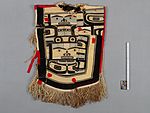Chilkat Tunic
About this object
History of use
Naaxiin (commonly called Chilkat) robes were symbols of wealth: to own them endowed a chief with great prestige. Even greater prestige resulted from giving them away at a potlatch. If there was no chief attending of high enough rank to receive it, the blanket might be cut into strips and distributed to a number of persons of prestige. These strips would be made into other ceremonial garments, such as shirts, aprons, leggings, headdresses, or bags. This tunic was sewn together from cut pieces of different robes. Weaver Evelyn Vanderhoop notes, “This tunic demonstrates the owner’s high rank, as he received enough cut Naaxiin pieces to create a single garment. If the tunic was created by assembling pieces received by both the wearer and his clan members, this could indicate not only his high standing, but that of his clan as well.” In comparing the fineness of the weaving, the style of the eyes (and other formlines), and colours of the dyed weft, it becomes apparent that the tunic’s pieces originate from different robes. The significance of the red pieces of cloth sewn onto the tunic is unknown at this time.
Narrative
This rare tunic was acquired around the late 1800s by William H. Collison, the first resident missionary on Haida Gwaii, however some of the pieces in the tunic may be from much older robes. Collison also spent time in the Upper Skeena and Nass River regions on the mainland so the exact origin of the tunic is unknown. It may have been made by Haida, Tsimshian, Nisga'a, Gitxsan, or Tlingit women at different times in the early to mid-nineteenth century.
Cultural context
ceremonial
Specific techniques
The warps utilize considerable amounts of yellow cedar bark and the wefts consist purely of mountain goat wool (as opposed to incorporation of commercial wools). Certain weaving techniques indicate the use of bone needles as opposed to metal.
Physical description
Tunic composed of fragments of other 'chilkat' style weavings. Six fragments are sewn together to form the front panel, and five fragments sewn together to form the back. The fragments have been sewn together to approximate the design of a Chilkat robe, with an abstract animal crest design in the centre, surrounded by a yellow and a black band at the edges of the tunic. Fringes hang from the bottom, and there is a fringed braid on sections of the sides. The rectangular tunic is stitched down one side, leaving 29 cm. for the armhole; cotton straps are sewn to the other side for tying. The neck has a fur band. The sides and shoulder seams are covered with narrow bands of red fabric. Six small patches of red fabric are appliqued to the front, and one to the back.
Categories
